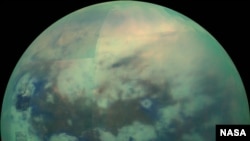While we may not get to that earth-like planet around Proxima Centauri anytime soon, NASA scientists are proposing all kinds of ways to explore the planets, moons, asteroids and various other rocky and icy things floating in and around our own solar system.
One of the coolest involves a proposal to explore the seas on Saturn's moon, Titan.
Checking in at the NIAC Symposium
The plan to head to Titan was laid out at NASA's annual Innovative Advanced Concepts (NIAC) Program Symposium held this week. The NIAC program is intended to fund visionary ideas that go way beyond things as mundane as going back to the moon or putting a colony on Mars. In fact, some of the ideas on display seem like science fiction, but this is all real, and while the missions and concepts can boggle the mind, they show just how deep into space NASA is looking.
But first, a bit about Titan. It's the second largest moon in our solar system, behind Ganymede, which orbits our largest planet, Jupiter.
It is a beautiful moon, at times looking positively earthlike with its cloud-filled skies. It is unique in that it has a dense atmosphere composed almost entirely of nitrogen with clouds of carbon-rich methane and ethane. Its surface is mostly ice and rocks. We only learned that in 2004, when the Cassini-Huygens spacecraft got close enough to peer through the yellowy nitrogen-carbon smog.
But Cassini also found liquid on Titan -- a lot of it, in the form of giant lakes of hydrocarbons. In fact, according to Jason Hartwig from NASA's Glenn Research Center, Titan is “the only other body, other than earth in our solar system, that has stable accessible seas.”
Hartwig is part of the team, called COMPASS, that NASA funded and asked to figure out a way to get to Titan and explore its great lakes.
Titan? Yes Titan!
There are three main seas on Titan -- Punga, Kraken and Ligeia Mare -- and together they are about as large as the Great Lakes here in the U.S. They are composed entirely of hydrocarbons, primarily methane and ethane. Hartwig says that's “about 100 times more liquefied natural gas on Titan than the whole planet earth combined.”
Exploring those seas, seeing what's in them, and perhaps more importantly, what's at the bottom of them, is what NASA's Titan Submarine project is all about.
That's right. Submarine. Team leader Steve Oleson, along with Hartwig and the rest of the COMPASS team, wants to send an autonomous submarine to Titan that would roam around, up and down these giant lakes.
They have a proposed launch date of 2038, a 7-year transit time and then a full year of this as-yet-unnamed sub cruising around on Titan. Why 2038? That's to make sure Saturn doesn't get between Titan and the earth, so NASA can talk to its little explorer.
Details, details, details
The submarine will be about 6 meters long, equipped with a small plutonium engine in the back called a Stirling radioisotope generator (SRG). The heat from the engine keeps the electronics in the front of the sub warm. That's vital because the hydrocarbon seas are a frigid minus 180 degrees celsius.
And the sub also has a potentially retractable sail that runs along its length. After 8 hours under Kraken Mare, it would resurface, Hartwig says, "and have 16 hours to communicate and recharge and all that."
From a layman's point of view this may seem a bit like a thought exercise. And to some extent it is. But so was going to the Moon until we did it. The level of detail that the team has drilled down to makes it clear they think this is something we can actually do.
One strategy they've put together to make this real is an exercise called a COMPASS run. Hartwig calls it "very intense." Basically, he says, "it's a bunch of people sitting together for 4 - 5 days straight trying to update the design."
They bash through every imaginable problem. “We are finding that the terrain around some of these seas is really quite treacherous,” Hartwig explains, so if the sub is, for instance, piggybacking on a probe that is exploring Titan's surface, they have to make sure it's sturdy enough to get to the water's edge. The more likely scenario is for the sub to be dropped directly into Kraken Mare from low orbit for a safe submarine splashdown.
Another COMPASS problem? Bubbles, caused by the hot sub hitting the cold hydrocarbons. "That waste heat we’re dumping into the liquid may be enough to cause bubbles," Hartwig says. Those bubbles can get in the way of cameras or even "coalesce at the aft end and cause our propellers to cavitate," which could stall the sub in the water.
Whether the project actually happens though is still uncertain, NASA has a notoriously tight budget. But it's fun to realize that we are in fact capable of achieving such an audacious voyage of discovery.












